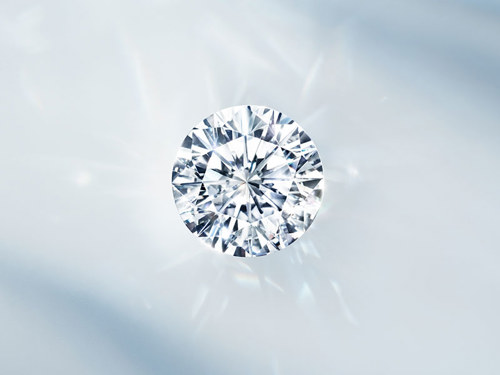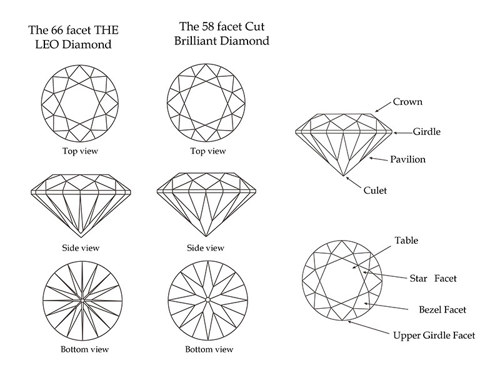In the realm of diamonds, the diversity of designs is staggering. Some are awe-inspiring, and others are, to put it mildly, unconventional. Each designer aspires to craft a unique piece that distinguishes them from their competition. However, not all designs are straightforward. This blog explores the various innovative designs the diamond industry has seen over the years and their impact on current and future diamond design.
Historical Innovative Diamond Designs
There are many designers who have pushed the boundaries of traditional diamond cutting, each contributing unique and influential designs to the industry. The late Gabriel ‘Gabi’ Tolkowsky introduced the Zoe cut, which featured nine main facet configurations, offering numerous virtual facets and a fresh aesthetic. However, the diamond industry did not fully embrace this design. I personally think Gabi was ahead of his time and the market wasn’t ready to accept the ‘out of the box’ concept. Following the Zoe cut, Gabi created the Gabrielle cut, which garnered high praise for its brilliance and beauty. The multiple tier faceting enhanced the light return and visual appeal over the ideal cut and round brilliant.

Other notable innovators include Christopher Slowinski who made his mark with his Crisscut® design, which is known for its visually striking scissor cut configurations. This design adds scintillation and more virtual facets, improving on the traditional Emerald cut.

Another famous diamond innovator was Leo Schachter, who introduced the Leo diamond which has additional facets on the pavilion which improves the light return of the diamond. Leo improved the Round Brilliant by adding facets that improve the light return with his design.


Clearly, while the Round Brilliant and Ideal Cut have been enduring designs, they can be improved upon to increase light return and visual appeal. The designers mentioned above, as well as others not mentioned, challenged the boundaries in diamond design and came up with great innovative ways to enhance the stone’s innate properties.
Among all the successful designs, the common thread running through them all is the same: Multiple Tier Faceting (MTF), a technique that involves cutting diamond facets in multiple layers (tiers). This method can significantly improve light return, scintillation (the sparkle of a diamond), and big flash (the diamond's ability to reflect light in a noticeable way). Chaumet even took things a step further with their Bee My Love range, featuring the Taille Impératrice hexagonal, multiple tier diamond with 88 inclined facets.
Dharmanandan Diamonds has created a visual that compares the light return of the Ideal round Brilliant to that of their multiple tier Sirius Star diamond. This visual demonstration underscores the crucial importance of light return in diamond design. The angle of light return increases significantly in the Sirius Star, a testament to its superior design. This serves as a reminder that the goal should always be to improve light return and visual appeal, rather than add weight to the diamond, thereby enhancing the overall understanding of diamond design.

Another notable innovation is the Floeting® Diamond, a creation of Ian Douglas from the Village Goldsmiths in Wellington, New Zealand, and a renowned diamond expert. This marks the first successful launch of a truly invisible setting for round diamonds. The adapted round brilliant diamond has undergone a transformation and is already proving to be a resounding success. The design ensures that the prongs or bezel will never wear away, preventing the diamond from dislodging.

Limits in Diamond-Cutting Creativity
Diamond is the hardest substance known to us and it’s non-isotropic structure can present complications in design and cutting of the stone. There are certain planes in the crystal structure that need to be avoided as facets cannot be cut and polished parallel to these planes. These are the cube plane and octahedral plane, which is the hardest. When it comes to new designs and innovative ideas, these principles have to be considered.
It’s worth noting that some designs, however creative, may be impractical to execute, considering the fact that diamonds are cut on a flat disc. By not keeping this in mind, challenges arise in creating a desirable product, particularly when designs venture into the concave space.
In order to create concave features, lasers need to be used, but that leaves the surfaces with opaque or at best, translucent surfaces. It is true that one can cut a diamond to look like a piece of cottage cheese – don’t laugh, I have had such a request recently, but it would be dull as lasing leaves unpolished surfaces that cannot be polished with extant technology.
Useful Design Tips
An important principle to consider when designing is facet definition. Robert Stickland, the creator of GemCad, notes that there should be at least 7 degrees of variation in either index, angle, or a combination of both. Going below 7 degrees becomes harder to execute and compromises facet definition. The maxim that the more difficult it is to cut and polish a diamond, the worse it will look should always be remembered.
Here are two images that show the increased light return which can be achieved with proper facet definition and Multiple Tier diamond facets. Light beams were directed in a 45 degrees segment for the Ideal Round Brilliant on the left and a MTF diamond on the right. The MTF diamond presents a wider arc of light return which maximizes the light return with no light leakage. Many people are not aware of the fact that even the best Brilliant Cut still leaks some light, however this is not significant. The greatest advantage of Multiple Tier diamond faceting is that the diamond has improved visual appeal and increased scintillation. It also has a lot of ‘Big Flash’ which is reminiscent of well-cut Old European Cut diamonds.
 |
 |
A Bright Future
Despite the current difficulties in the diamond market, there is a silver lining. With endless possibilities in diamond design and setting innovation, the jewelry industry is not just poised, but primed to experience a renewed surge in market share. This potential for growth should inspire optimism and excitement for the future.


 RapNet Blog
RapNet Blog
![Diamonds 6[1][1]](/media/2120/diamonds-6-1-1.png)